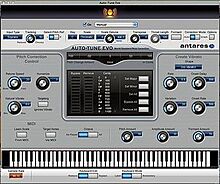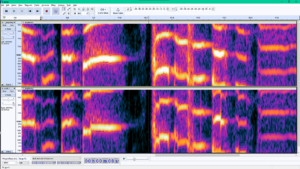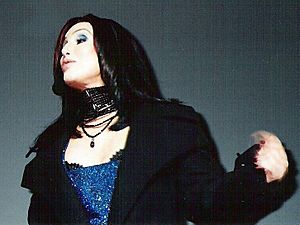Auto-Tune facts for kids

Auto-Tune running on GarageBand
|
|
| Original author(s) | Dr. Andy Hildebrand |
|---|---|
| Developer(s) | Antares Audio Technologies |
| Initial release | September 19, 1997 |
| Stable release |
10
|
| Operating system | Microsoft Windows and macOS |
| Type | Pitch correction |
| License | Proprietary |
Auto-Tune, or autotune, is an audio processor introduced in 1997 by the American company Antares Audio Technologies. It uses a proprietary device to measure and alter pitch in vocal and instrumental music recording and performances.
Auto-Tune was originally intended to disguise or correct off-key inaccuracies, allowing vocal tracks to be perfectly tuned. The 1998 Cher song "Believe" popularized the technique of using Auto-Tune to distort vocals. In 2018, the music critic Simon Reynolds observed that Auto-Tune had "revolutionized popular music", calling its use for effects "the fad that just wouldn't fade. Its use is now more entrenched than ever."
In its role of distorting vocals, Auto-Tune operates on different principles from the vocoder or talk box and produces different results.
Contents
Function

Auto-Tune is available as a plug-in for digital audio workstations used in a studio setting and as a stand-alone, rack-mounted unit for live performance processing. The processor slightly shifts pitches to the nearest true, correct semitone (to the exact pitch of the nearest note in traditional equal temperament). Auto-Tune can also be used as an effect to distort the human voice when pitch is raised or lowered significantly, such that the voice is heard to leap from note to note stepwise, like a synthesizer.
Auto-Tune has become standard equipment in professional recording studios. Instruments such as the Peavey AT-200 guitar seamlessly use Auto-Tune technology for real-time pitch correction.
Development
Auto-Tune was developed by Andy Hildebrand, a Ph.D. research engineer who specialized in stochastic estimation theory and digital signal processing. Hildebrand conceived the vocal pitch correction technology on the suggestion of a colleague's wife, who had joked that she could benefit from a device to help her sing in tune.
Over several months in early 1996, he implemented the algorithm on a custom Macintosh computer and presented the result at the NAMM Show later that year, where "it was instantly a massive hit". Hildebrand's method for detecting pitch involved the use of autocorrelation and proved superior to earlier attempts based on feature extraction that had problems processing certain aspects of the human voice such as diphthongs, leading to sound artifacts. Music engineers had previously considered autocorrelation impractical because of the massive computational effort required, but Hildebrand found a "mathematical trick" to overcome this, "a simplification [that] changed a million multiply adds into just four".
According to the Auto-Tune patent, the referred implementation detail consists, when processing new samples, of reusing the former autocorrelation bin, and adding the product of the new sample with the older sample corresponding to a lag value, while subtracting the autocorrelation product of the sample that correspondingly got out of window.
Originally, Auto-Tune was designed to discreetly correct imprecise intonations to make music more expressive, with the original patent asserting: "When voices or instruments are out of tune, the emotional qualities of the performance are lost." Auto-Tune was launched in September 1997.
Use in music

Auto-Tune was popularized by Cher's 1998 song "Believe". While Auto-Tune was designed to be used subtly to correct vocal performances, the "Believe" producers used extreme settings to create unnaturally rapid corrections in Cher's vocals, thereby removing portamento, the natural slide between pitches in singing. In an attempt to protect their method, they initially claimed the effect was achieved using a vocoder. It was widely imitated and became known as the "Cher effect".
While Cher's song "Believe" has become famous for achieving the exaggerated Auto-Tune effect, it was not the first popular song to use it. Released two months prior to the album "Believe", the Kid Rock song "Only God Knows Why", taken from his Devil Without a Cause album, was the first popular song to utilize the vocoder-like Auto-Tune effect, and also used it to a greater extent. According to Pitchfork, 1999 "Too Much of Heaven" by Italian Europop group Eiffel 65 features "the very first example of rapping through Auto-Tune". The group's member Gabry Ponte stated that their usage of the effect was inspired by Cher's "Believe".
The English rock band Radiohead used Auto-Tune on their 2001 album Amnesiac to create a "nasal, depersonalized sound" and to process speech into melody. According to the Radiohead singer, Thom Yorke, Auto-Tune "desperately tries to search for the music in your speech, and produces notes at random. If you've assigned it a key, you've got music."
In the mid and late 2000s, musician T-Pain used Auto-Tune extensively, further popularizing use of the effect. He cited the new jack swing producer Teddy Riley and funk artist Roger Troutman's use of the talk box as inspirations for his use of Auto-Tune. T-Pain became so associated with Auto-Tune that he had an iPhone app named after him that simulated the effect, "I Am T-Pain". Eventually dubbed the "T-Pain effect", the use of Auto-Tune became a fixture of late 2000s music, where it was notably used in other hip hop/R&B artists' works, including Lil Wayne's "Lollipop" and Kanye West's album 808s & Heartbreak. In 2009 the Black Eyed Peas' number-one hit "Boom Boom Pow", made heavy use of Auto-Tune on their vocals to create a futuristic sound. The use of Auto-Tune in hip hop gained a resurgence in the mid-2010s, especially in trap music, with artists like Future, Playboi Carti, Travis Scott, and Lil Uzi Vert using Auto-Tune to create a signature sound.
The effect has also become popular in raï music and other genres from Northern Africa. According to the Boston Herald, country stars Faith Hill, Shania Twain, and Tim McGraw use Auto-Tune in performance, calling it a safety net that guarantees a good performance. However, other country music singers, such as Allison Moorer, Garth Brooks, Big & Rich, Trisha Yearwood, Vince Gill and Martina McBride, have refused to use Auto-Tune.
See also
 In Spanish: Auto-Tune para niños
In Spanish: Auto-Tune para niños
- Audio time stretching and pitch scaling
- Melodyne, a similar product
- Overproduction (music)
- Robotic voice effects


